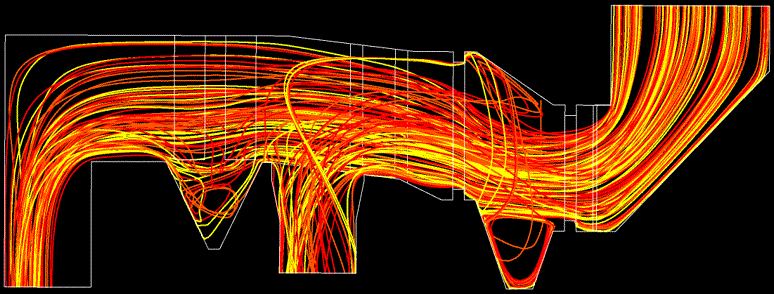COVENTILATION™ SERVICES
HVAC System Analysis and Redesign
- QUALITATIVE REVIEW
- Examine air flow into, out of, and within the space.
- Visualize flow patterns using various point sources
(Smoke preferred. See Flow Visualization link below).
- Suggest steps that could be taken immediately
to improve IAQ.
. - Familiarization and Education
- Airborne particulate, aerosolized vapors and second hand smoke; what they have in common.
(Refer to Ventilation Basics and Ventilation Letter)
- Examples of Flow Visualization for Industrial spaces.
(Commercial examples to be added later.)
. - QUANTITATIVE ANALYSIS
- Detailed recommendations would require additional DE analysis and design activities that may include physical and/or computer modeling. (Refer to Modeling Tools.)
- Additional consulting services would be quoted separately.
. - DELIVERABLES FROM QUANTITATIVE ANALYSIS
- Summary of findings (written report).
- Recommendations for improving air admission, exhaust, and movement of air within the space using The CoVentilation Method™.
- Photos and videos of assessment and testing activities.
. - Ventilation Services - Contact Form & Pricing
NOTE - Modification to ventilation system should be done by
qualified HVAC contractors. (Others, not DE.)
- Building a 'COVENTILATION™' Awareness Community
Individuals, groups and businesses working towards new ventilation practices to reduce recirculation and recycling of harmful airborne particles.

DE specializes in gas flow pattern analysis and modification within industrial scale equipment to improve process efficiency and reduce O&M costs. Tools and techniques developed over the past 30-years are applicable from the industrial scale to laboratory scale. The type of flow discussed here is non-reacting, particle laden turbulent flow. Commercial space dimensions lie within the industrial and model scale range.
Across the range of sizes, enclosed spaces have boundary walls that define the space (they are all ducts: flow in, flow out, and containment walls). Air/gas flow in and out are defined by the needs of the process. Within the space, flow patterns are affected by the location of inlets and outlets, and by passive and active elements within: heat exchangers and gas conditioning equipment, and partitions, office equipment, and people in commercial spaces.
Flow pattern analysis is performed to address issues of concern such as: high or low flow areas, hot and cold zones, too much or not enough mixing, etc. Based on the analysis, flow modification methods may be recommended to promote process efficiency, to prevent damage to internal components or to purge the volume.
For commercial spaces, internal flow pattern is a concern due to transport mechanisms associated with airborne vapors and particles. The desired outcome would be reduced mixing and residence time for particles that may pose an inhalation hazard.
DE services include qualitative (flow visualization) and quantitative (flow measurement) examination of air flow into, out of, and within the space. Extended analysis could include physical and/or computer modeling of gas and particle trajectories to reveal more detail about baseline flow patterns and then to evaluate proposed modification methods.
DE is not a Heating Ventilating and Air Conditioning (HVAC) enterprise. DE Services include the analysis described above. Deliverables include the analysis and recommendations for modifications to the HVAC equipment to bring about the agreed to changes. HVAC vendors or other contractors would design, select, fabricate and install devices needed to achieve the recommended modifications.